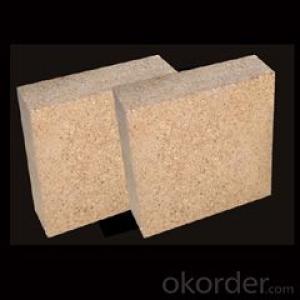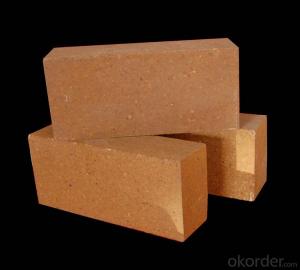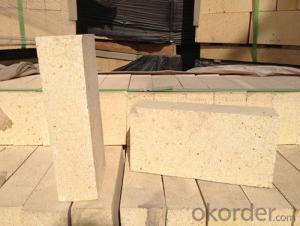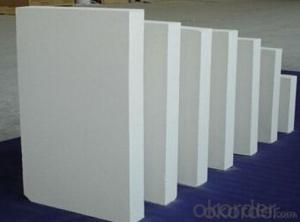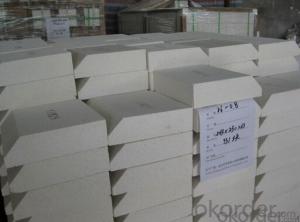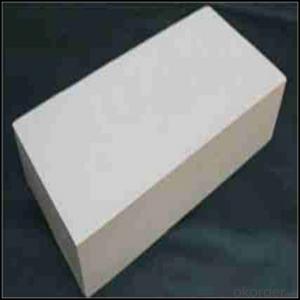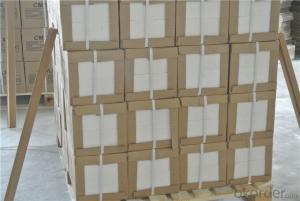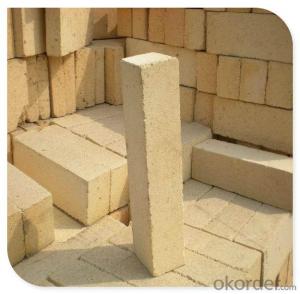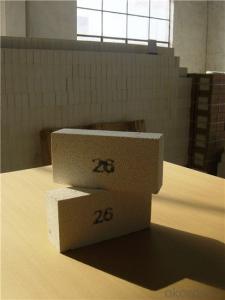Insulating Fire Brick - Refractory Thermal Insulation Magnesia Fire Bricks for Electric Furnace
- Loading Port:
- Shanghai
- Payment Terms:
- TT OR LC
- Min Order Qty:
- 10 m.t.
- Supply Capability:
- 100 m.t./month
OKorder Service Pledge
OKorder Financial Service
You Might Also Like
Quick Details
| Place of Origin: | (Mainland) | Shape: | Brick | Material: | MgO-Carbon Brick |
| SiO2 Content (%): | customized | Al2O3 Content (%): | customized | MgO Content (%): | ≥78 |
| CaO Content (%): | 0 | Refractoriness (Degree): | 1770°< Refractoriness< 2000° | Model Number: | YH-MT10B |
| Brand Name: |
| Bulk density(g/cm³): | ≥2.9g/cm³ | Apparent porosity(%): | ≤5 |
| C(%): | ≥10 | compressive strengthMPa): | ≥35 | High Temperature Flexural strength(MPa): | ≥6 |
Packaging & Delivery
| Packaging Detail: | The refractory thermal insulation magnesia fire bricks for electric furnace is packed on wooden pallets with three layers water-proof shrink film and tightened with plastic/steel bandages,when in the transportation process of magnesia carbon brick,we should pay attention to moisture and light handling. |
| Delivery Detail: | 7-15 working days |
Specifications
1.High slag resistance& high refractoriness&high strength
2.Approved by SINOSTEEL
3.Factory direct price
4.ISO certificate
Refractory Thermal Insulation Magnesia Fire Bricks for Electric Furnace
![]()
YH-MT Series refractory thermal insulation magnesia fire bricks for electric furnace are designed and manufactured as per the different usage parts and working conditions of electric furnace, converter and ladle. It is shaped by high purity and high compact or large crystalline fused magnesia and high purity graphite as main materials and phenolic resin as binder.This kind of lime kiln used magnesia brick is mainly applied for the lining parts of electric furnace and converter.Directly touching molten steel and slag,it has the advantages of high strength,high slag resistance,good thermal stability and high refractoriness.According to melting conditions,different grades of magnesia carbon refractory brick should be chosen for the various usage parts of furnace body and ladle.
Main Chemical Compositions and Physical Properties
![]()
| Items | YH-MT10A | YH-MT10B | YH-MT14A | YH-MT14B | YH-MT16A | |
| Chemical Compositions(%) | MgO | 80 | 78 | 76 | 74 | 74 |
| C | 10 | 10 | 14 | 14 | 16 | |
| Apparent Porosity(%) | 4 | 5 | 4 | 5 | 5 | |
| Bulk Density(g/cm³) | 2.95 | 2.9 | 2.95 | 2.95 | 2.9 | |
| Compressive Strength(Mpa) | 40 | 35 | 40 | 40 | 35 | |
| High Temperature Flexural Strength(Mpa) | 6 | 6 | 10 | 10 | 7 | |
Product Show of Refractory Thermal Insulation Magnesia Fire Bricks
Packing Method of Refractory Thermal Insulation Magnesia Fire Bricks
![]()
1.The refractory thermal insulation magnesia fire bricks for electric furnace will be packed as the standard of exporting, used wooden pallet with plastic/steel bandages,when in the transportation process of magnesia carbon brick,we should pay attention to moisture and light handling.
2.The packing of refractory thermal insulation magnesia fire bricks for electric furnace will accept customer's requirement if any.
3.Delivery within 7-15 working days after your payment.
4.Fast delievery accepted by customers.
Our Service ![]()
1. We could send the Technology Staff to help you to install
2.We could keep in touch with you any time for answering your questions
3.We could design the Refractory Solution for you according to your Drawing of Vessel
4.We could provide you a perfect after sale service
- Q: Refractory bricks, burner bricks, insulation bricks? Is it a kind of thing?
- Not the same thing, refractory bricks and insulation bricks of raw materials, the proportion is not the same. This is the chain of various types of products
- Q: Can insulating fire bricks be used in the construction of smelter crucibles?
- Yes, insulating fire bricks can be used in the construction of smelter crucibles. These bricks are designed to withstand high temperatures and provide excellent insulation, making them suitable for use in smelting applications. They help to retain heat and minimize heat loss, ensuring efficient and effective smelting processes.
- Q: Are insulating fire bricks resistant to phosphoric acid?
- Phosphoric acid, being a strong acid, has the potential to react with and corrode various materials, including fire bricks. Although certain fire bricks may possess a degree of resistance to acidic conditions, insulating fire bricks are generally not equipped to endure prolonged exposure to phosphoric acid without experiencing notable deterioration. As a result, it is advisable to employ acid-resistant materials like acid-resistant bricks or linings when handling phosphoric acid or other potent acids.
- Q: How do insulating fire bricks affect the overall sustainability of a structure?
- Insulating fire bricks play a crucial role in enhancing the overall sustainability of a structure. These bricks are specifically designed to provide superior thermal insulation, reducing heat transfer and enhancing energy efficiency. By minimizing heat loss or gain, insulating fire bricks contribute to a more sustainable structure in various ways. Firstly, insulating fire bricks help reduce energy consumption by maintaining a stable indoor temperature. With their high insulating properties, these bricks prevent heat loss during the winter and heat gain during the summer. This reduces the reliance on heating and cooling systems, thereby lowering energy consumption and associated greenhouse gas emissions. Secondly, the improved thermal insulation provided by insulating fire bricks can result in significant cost savings. Reduced energy consumption translates into lower utility bills, making the structure more economically sustainable in the long run. Moreover, the durability and longevity of these bricks ensure that replacements or repairs are less frequent, further enhancing the economic sustainability of the structure. Additionally, insulating fire bricks contribute to the sustainability of a structure by improving occupant comfort. With better insulation, the indoor temperature remains stable, creating a more comfortable living or working environment. This reduces the need for additional heating or cooling, enhancing the overall well-being and satisfaction of the occupants. Furthermore, insulating fire bricks also have a positive impact on environmental sustainability. By reducing energy consumption, these bricks contribute to the conservation of natural resources and minimize the carbon footprint of the structure. The decreased reliance on fossil fuel-based energy sources helps mitigate climate change and reduce air pollution. In summary, insulating fire bricks have a significant positive impact on the overall sustainability of a structure. They reduce energy consumption, enhance energy efficiency, lower costs, improve occupant comfort, and contribute to environmental sustainability. Therefore, incorporating insulating fire bricks in a structure's design and construction is an effective way to promote sustainability and create a more environmentally friendly and economically viable building.
- Q: How durable are insulating fire bricks?
- Insulating fire bricks are renowned for their remarkable strength and endurance. These bricks are crafted from top-notch refractory materials like alumina and silica, which possess superb thermal resistance and mechanical robustness. As a result, insulating fire bricks can endure extreme temperatures ranging from 1300°C to 1800°C (2372°F to 3272°F) without compromising their structural integrity. The durability of insulating fire bricks can be attributed to several key factors. Firstly, their low thermal conductivity enables them to effectively insulate heat and prevent thermal shock, which is pivotal for ensuring their long-term sturdiness. Additionally, the high melting point of the refractory materials utilized in their production enhances their ability to withstand intense heat. Furthermore, insulating fire bricks exhibit resistance against chemical erosion and corrosion, making them ideal for diverse industrial applications. They can withstand exposure to harsh chemicals, acids, and alkalis, guaranteeing their durability even in demanding environments. Moreover, insulating fire bricks possess a low density, rendering them lightweight and less prone to cracking or breaking under pressure. This characteristic heightens their durability and facilitates ease of handling during installation or maintenance. In summary, insulating fire bricks are exceedingly durable and capable of withstanding extreme temperatures, thermal shock, chemical erosion, and mechanical stress. Their exceptional durability positions them as the preferred choice for applications such as furnaces, kilns, ovens, and other high-temperature environments where thermal insulation and long-lasting performance are imperative.
- Q: Are insulating fire bricks suitable for use in the construction of smelters?
- Yes, insulating fire bricks are suitable for use in the construction of smelters. These bricks are designed to withstand high temperatures and provide excellent insulation properties, making them ideal for lining the walls and floors of smelters. They help to retain heat, reduce energy loss, and protect the structure from extreme heat. Additionally, insulating fire bricks are lightweight and easy to install, making them a preferred choice for smelter construction.
- Q: Can insulating fire bricks be used for insulation in furnaces?
- Yes, insulating fire bricks can be used for insulation in furnaces. These bricks are designed to withstand high temperatures and provide excellent thermal insulation, making them suitable for use in furnaces to reduce heat loss and increase energy efficiency.
- Q: Are insulating fire bricks resistant to metal penetration?
- Insulating fire bricks possess a general resistance to the penetration of metal. These bricks are composed of refractory materials with high melting points and are engineered to endure elevated temperatures. Their application is often found in environments subject to extreme heat, such as furnaces and kilns. The thermal conductivity of insulating fire bricks is low, denoting their effectiveness in impeding heat transfer. This characteristic aids in maintaining a cool outer surface for the bricks, even when the interior is subjected to intense heat. Consequently, such bricks exhibit the ability to withstand the infiltration of molten metal. Nonetheless, it is worth noting that the resistance of insulating fire bricks to metal penetration varies according to the individual composition and quality of the bricks. Inferior-grade bricks may not offer the same level of resistance as their higher-quality counterparts. Furthermore, the duration and intensity of exposure to heat can also influence the bricks' resistance. In conclusion, while insulating fire bricks generally exhibit resistance to metal penetration, it is vital to consider the specific attributes and quality of the bricks employed, as well as the conditions under which they are exposed to heat.
- Q: Are insulating fire bricks resistant to alkali-silica reaction?
- Insulating fire bricks (IFBs) are not inherently resistant to alkali-silica reaction (ASR). ASR is a chemical reaction that occurs between the alkalis from cement and reactive forms of silica present in aggregates, which can lead to the formation of a gel that expands and causes cracking in concrete structures. While IFBs are generally made from refractory materials that are designed to withstand high temperatures and thermal shock, they do not have specific properties to resist ASR. The resistance to ASR depends on the composition and characteristics of the specific refractory material used in the IFB. If the refractory material used in the IFB contains reactive forms of silica, such as quartz or cristobalite, and there is exposure to alkalis, there is a possibility of ASR occurring. However, if the refractory material is low in reactive silica content or contains additives that can mitigate ASR, the risk of ASR may be minimized. It is important to note that the primary purpose of IFBs is to provide insulation in high-temperature applications, such as kilns, furnaces, and fireplaces. If ASR resistance is a critical requirement for a specific application, it is recommended to consult with the manufacturer or a materials engineer to determine the suitability of the IFB for that particular scenario.
- Q: Can insulating fire bricks be used as a lining for chimneys?
- Yes, insulating fire bricks can be used as a lining for chimneys. These bricks are designed to withstand high temperatures and provide insulation, making them suitable for lining chimneys and protecting them from heat damage.
Send your message to us
Insulating Fire Brick - Refractory Thermal Insulation Magnesia Fire Bricks for Electric Furnace
- Loading Port:
- Shanghai
- Payment Terms:
- TT OR LC
- Min Order Qty:
- 10 m.t.
- Supply Capability:
- 100 m.t./month
OKorder Service Pledge
OKorder Financial Service
Similar products
Hot products
Hot Searches
Related keywords
